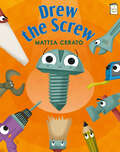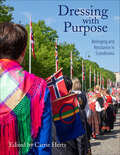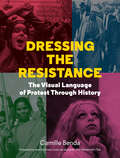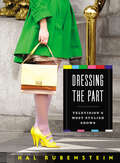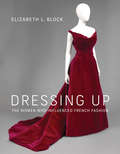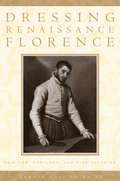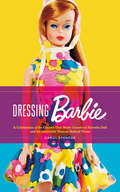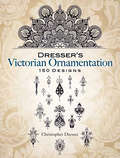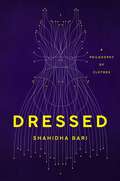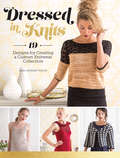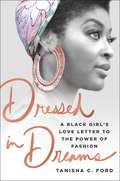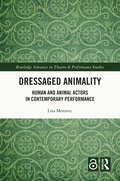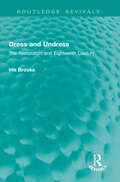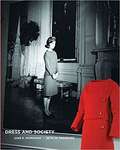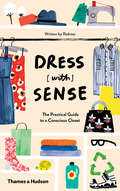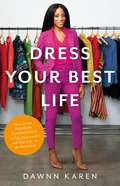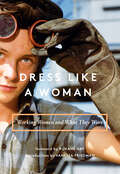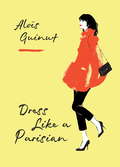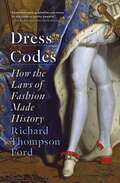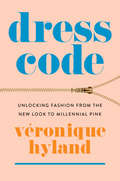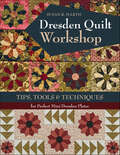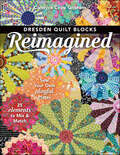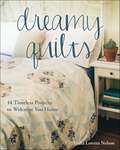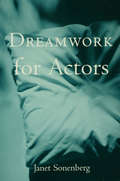- Table View
- List View
Drew the Screw (I Like to Read)
by Mattia CeratoEvery tool has a job—but what can Drew the Screw do? Find out in this Level E reader, perfect for Kindergarten and first-grade readers. The pencil draws lines. The saw can cut. But unlike everyone else in the toolshed, Drew the screw has no job. He watches as one by one the tools show off their skills . . . and then he finds his own hidden talent, holding up a Home, Sweet Home sign in a newly-built treehouse. Bright digital drawings of cartoonish tools happily going about their jobs are paired with a very simple text, appropriate for children just beginning to read on their own. Explore all the different things tools can do—and the joy of finding your own special talents!—with Drew. The award-winning I Like to Read® series focuses on guided reading levels A through G, based upon Fountas and Pinnell standards. Acclaimed author-illustrators--including winners of Caldecott, Theodor Seuss Geisel, and Coretta Scott King honors—create original, high quality illustrations that support comprehension of simple text and are fun for kids to read with parents, teachers, or on their own! Level E stories feature a distinct beginning, middle, and end, with kid-friendly illustrations offering clues for more challenging sentences. Varied punctuation and simple contractions may be included. Level E books are suitable for early first graders. When Level E is mastered, follow up with Level F.
Dressing with Purpose: Belonging and Resistance in Scandinavia
by Carrie HertzDress helps us fashion identity, history, community, and place. Dress has been harnessed as a metaphor for both progress and stability, the exotic and the utopian, oppression and freedom, belonging and resistance. Dressing with Purpose examines three Scandinavian dress traditions—Swedish folkdräkt, Norwegian bunad, and Sámi gákti—and traces their development during two centuries of social and political change across northern Europe. By the 20th century, many in Sweden worried about the ravages of industrialization, urbanization, and emigration on traditional ways of life. Norway was gripped in a struggle for national independence. Indigenous Sámi communities—artificially divided by national borders and long resisting colonial control—rose up in protests that demanded political recognition and sparked cultural renewal. Within this context of European nation-building, colonial expansion, and Indigenous activism, traditional dress took on special meaning as folk, national, or ethnic minority costumes—complex categories that deserve reexamination today. Through lavishly illustrated and richly detailed case studies, Dressing with Purpose introduces readers to individuals who adapt and revitalize dress traditions to articulate who they are, proclaim personal values and group allegiances, strive for sartorial excellence, reflect critically on the past, and ultimately, reshape the societies they live in.
Dressing the Resistance: The Visual Language of Protest
by Camille BendaDressing the Resistance is a celebration of how we use clothing, fashion, and costume to ignite activism and spur social change.Weaving together historical and current protest movements across the globe, Dressing the Resistance explores how everyday people and the societies they live in harness the visual power of dress to fight for radical change. American suffragettes made and wore dresses from old newspapers printed with voting slogans. Male farmers in rural India wore their wives' saris while staging sit-ins on railroad tracks against government neglect. Costume designer and dress historian Camille Benda analyzes cultural movements and the clothes that defined them through nearly 200 archival images, photographs, and paintings that bring each event to life, from ancient Roman rebellions to the #MeToo movement, from twentieth century punk subcultures to Black Lives Matter marches.
Dressing the Part: Television's Most Stylish Shows
by Hal RubensteinFrom longtime fashion director, consultant, media personality, and author, Hal Rubenstein, comes a lush, full color, illustrated guide to the most influential fashion on television from the 1950s to today, revealing the surprising ways our favorite shows have significantly reflected and often shaped the way we dress. No other medium has shaped our lives as thoroughly and consistently as television. Since its advent in the 1950s, television has served as a portal for discovering culture, initiating trends, and altering shared perceptions. Yet as Hal Rubenstein contends, television has done much more; its most dramatic, lasting, and effective influence can be found in our closets. Our most popular and lasting fashion trends and hallmarks of personal style haven’t come from runways or magazines, but from what’s on TV. For decades television has served as a personal stylist, showing us how others dress and defining what we should be wearing.From Mary Tyler Moore's capri pants on The Dick van Dyke Show and Emma Peel's dominatrix jumpsuit on The Avengers to Olivia Pope's trademark white trench on Scandal and Don Drapers' grey sharkskin suits on Mad Men Dressing the Part is a rich history of popular American fashion and culture in the modern age. In this gorgeous compendium, the longtime fashion director and expert identifies the most stylish television shows of the past 70 years, highlighting the ways they have affected and often inspired ordinary Americans’ wardrobes. Combining his decades of fashion expertise and insider knowledge with lush photographs, archival sketches, fascinating interviews with over two dozen of television’s best costume designers, commentary from showrunners and co-stars, and little-known backstories, Rubenstein reveals with insight and wit how television has shaped everyday fashion, guiding and often elevating how we dress.Illustrated with over 175 gorgeous, full-color photographs, Dressing the Part is an extraordinary survey of our most beloved shows and their most enduring impact on style, shining a spotlight on the most innate human characteristics of all—how we imitate and then adapt what we enjoy seeing on others.
Dressing Up: The Women Who Influenced French Fashion
by Elizabeth L. BlockHow wealthy American women--as consumers and as influencers--helped shape French couture of the late nineteenth century; lavishly illustrated.French fashion of the late nineteenth century is known for its allure, its ineffable chic--think of John Singer Sargent's Madame X and her scandalously slipping strap. For Parisian couturiers and their American customers, it was also serious business. In Dressing Up, Elizabeth Block examines the couturiers' influential clientele--wealthy American women who bolstered the French fashion industry with a steady stream of orders from the United States. Countering the usual narrative of the designer as solo creative genius, Block shows that these women--as high-volume customers and as pre-Internet influencers--were active participants in the era's transnational fashion system.Block describes the arrival of nouveau riche Americans on the French fashion scene, joining European royalty, French socialites, and famous actresses on the client rosters of the best fashion houses--Charles Frederick Worth, Doucet, and Félix, among others. She considers the mutual dependence of couture and coiffure; the participation of couturiers in international expositions (with mixed financial results); the distinctive shopping practices of American women, which ranged from extensive transatlantic travel to quick trips downtown to the department store; the performance of conspicuous consumption at balls and soirées; the impact of American tariffs on the French fashion industry; and the emergence of smuggling, theft, and illicit copying of French fashions in the American market as the middle class emulated the preferences of the rich. Lavishly illustrated, with vibrant images of dresses, portraits, and fashion plates, Dressing Up reveals the power of American women in French couture.Winner of the Aileen Ribeiro Grant of the Association of Dress Historians; an Association for Art History grant; and a Pasold Research Fund grant.
Dressing Renaissance Florence: Families, Fortunes, and Fine Clothing (The Johns Hopkins University Studies in Historical and Political Science #120)
by Carole Collier FrickAs portraits, private diaries, and estate inventories make clear, elite families of the Italian Renaissance were obsessed with fashion, investing as much as forty percent of their fortunes on clothing. In fact, the most elaborate outfits of the period could cost more than a good-sized farm out in the Mugello. Yet despite its prominence in both daily life and the economy, clothing has been largely overlooked in the rich historiography of Renaissance Italy. In Dressing Renaissance Florence, however, Carole Collier Frick provides the first in-depth study of the Renaissance fashion industry, focusing on Florence, a city founded on cloth, a city of wool manufacturers, finishers, and merchants, of silk dyers, brocade weavers, pearl dealers, and goldsmiths. From the artisans who designed and assembled the outfits to the families who amassed fabulous wardrobes, Frick's wide-ranging and innovative interdisciplinary history explores the social and political implications of clothing in Renaissance Italy's most style-conscious city.Frick begins with a detailed account of the industry itself—its organization within the guild structure of the city, the specialized work done by male and female workers of differing social status, the materials used and their sources, and the garments and accessories produced. She then shows how the driving force behind the growth of the industry was the elite families of Florence, who, in order to maintain their social standing and family honor, made continuous purchases of clothing—whether for everyday use or special occasions—for their families and households. And she concludes with an analysis of the clothes themselves: what pieces made up an outfit; how outfits differed for men, women, and children; and what colors, fabrics, and design elements were popular. Further, and perhaps more basically, she asks how we know what we know about Renaissance fashion and looks to both Florence's sumptuary laws, which defined what could be worn on the streets, and the depiction of contemporary clothing in Florentine art for the answer.For Florence's elite, appearance and display were intimately bound up with self-identity. Dressing Renaissance Florence enables us to better understand the social and cultural milieu of Renaissance Italy.
Dressing Barbie: A Celebration of the Clothes That Made America’s Favorite Doll and the Incredible Woman Behind Them
by Carol SpencerA legendary fashion designer for Barbie shares the story of her adventures working behind-the-scenes at Mattel, and spotlights the creations that transformed the world’s most famous doll into a style icon in this beautifully designed book—published in commemoration of Barbie’s sixtieth anniversary—illustrated with 100 full-color photographs, including many never-before-seen images of rare and one-of-a-kind pieces from the author’s private archive.Dressing Barbie is a dazzling celebration of the clothes that made America’s favorite doll, and the incredible woman behind them. For thirty-five years, Carol Spencer enjoyed an unparalleled reign as a Barbie fashion designer, creating some of Barbie’s most iconic looks from the early 1960s until the late 1990s.Barbie’s wide-ranging wardrobe—including princess gowns and daisy-print rompers, flirty sundresses and smart pantsuits— combined fashion trends and haute couture with a liberal dose of fantasy. In Dressing Barbie, the successful and prolific designer reminisces about her time at Mattel working with legendary figures such as Ruth Handler, Barbie’s creator, and Charlotte Johnson, the original Barbie designer, and talks about her best and most beloved clothing designs from each decade. But Carol’s most impressive creation is her own life. As Handler famously said, “Barbie always represented the fact that a girl has choices”—a credo Carol epitomized. In Dressing Barbie, she talks candidly about how she broke free of the constraints of the late 1950s to pursue a dazzling career and an independent life for herself.Over the course of her successful and prolific career, Carol won many accolades. She was the first designer to have her signature on the doll, the first to go on a signing tour, the first to design a limited-edition Barbie Doll for collectors, and the designer of the biggest selling Barbie of all time. Now, Carol is the first member of the inner circle to take fans behind the pink curtain, revealing the fashion world of Barbie, the quintessential California girl, as never before.
Dresser's Victorian Ornamentation
by Christopher DresserBorders in the style of medieval manuscripts, patterns based on Greek and Persian pottery, designs adapted from Venetian lace--this unique sourcebook abounds in splendid original ornaments. Its gorgeous black-and-white drawings include such diverse influences as German Gothic, Japanese, Arabic, Indian, Celtic, and ancient Roman art.A pioneer of modern design, Christopher Dresser (1834-1904) was one of the Victorian era's most important and influential stylists, whose works are eagerly sought by artists and craftspeople. A botanist by training, Dresser was particularly skilled in the execution of floral motifs. This versatile collection of his designs can be easily adapted to art and craft projects, textiles, interior decoration, wall hangings, lacework, carvings, and much more.
Dressed: A Philosophy of Clothes
by Shahidha BariPerfect for readers of Women in Clothes, this beautifully designed philosophical guide to fashion explores art, literature, and film to uncover the hidden meaning of a well-chosen wardrobe.We all get dressed. But how often do we pause to think about what our clothes say? When we dress ourselves, we are presenting to the world an essence of who we are, who we want to be.Dressed ranges freely from suits to suitcases, from Marx's coat to Madame X's gown. Through art and literature, film and philosophy, philosopher Shahidha Bari unveils the surprising personal implications of what we choose to wear. The impeccable cut of Cary Grant's suit projects masculine confidence, just as Madonna's oversized denim jacket and her armful of orange bangles loudly announces big ambition. How others dress tells us something fundamental about them -- we can better understand how people live and what they think through their garments. Clothes tell our stories.Dressed is the thinking person's fashion book. In baring the hidden power of clothes in our culture and our daily lives, Bari reveals how our outfits not only cover our bodies but also reflect our minds.
Dressed in Knits: 19 Designs for Creating a Custom Knitwear Collection
by Alex Capshaw-TaylorKnit your own couture wardrobe!As a knitter, you know the appeal of creating a piece that can go from home to office, from weekday to weekend--and, most importantly, that looks flattering on your figure. But that can be easier said than done! Until now.Knitwear designer Alex Capshaw-Taylor has created a collection of 19 knitted garments and accessories featuring timeless, high-fashion designs that are refreshingly easy to wear.In Dressed in Knits, you'll experiment with a variety of techniques including multidirectional knitting, colorwork (intarsia and stranded), cabling, and more. Unique to this guide is helpful information devoted to educating knitters on couture details that produce designer quality finished pieces. Alex will demonstrate proper seeming, picking up stitches, applying beads, turning a hem, creating pockets, steeking, adding zippers to knitwear, and more. Helpful tips on styling finished garments will also be sprinkled throughout the book, like how adding a belt to a piece can change the silhouette giving it a totally different look.Dressed in Knits isn't just another knitting book. It's your fashion-forward guide to a whole new wardrobe.
Dressed in Dreams: A Black Girl's Love Letter to the Power of Fashion
by Tanisha C. FordFrom sneakers to leather jackets, a bold, witty, and deeply personal dive into Black America's closet In this highly engaging book, fashionista and pop culture expert Tanisha C. Ford investigates Afros and dashikis, go-go boots and hotpants of the sixties, hip hop's baggy jeans and bamboo earrings, and the #BlackLivesMatter-inspired hoodies of today. <P><P>The history of these garments is deeply intertwined with Ford’s story as a black girl coming of age in a Midwestern rust belt city. She experimented with the Jheri curl; discovered how wearing the wrong color tennis shoes at the roller rink during the drug and gang wars of the 1980s could get you beaten; and rocked oversized, brightly colored jeans and Timberlands at an elite boarding school where the white upper crust wore conservative wool shift dresses. Dressed in Dreams is a story of desire, access, conformity, and black innovation that explains things like the importance of knockoff culture; the role of “ghetto fabulous” full-length furs and colorful leather in the 1990s; how black girls make magic out of a dollar store t-shirt, rhinestones, and airbrushed paint; and black parents' emphasis on dressing nice. Ford talks about the pain of seeing black style appropriated by the mainstream fashion industry and fashion’s power, especially in middle America. <P><P>In this richly evocative narrative, she shares her lifelong fashion revolution—from figuring out her own personal style to discovering what makes Midwestern fashion a real thing too.
Dressaged Animality: Human and Animal Actors in Contemporary Performance (Routledge Advances in Theatre & Performance Studies)
by Lisa MoravecThe book applies a productive interdisciplinary lens of art history, performance, and animal studies for approaching political economy issues, critiquing anthropomorphic worldviews, and provoking thoughts around animal and human nature that spark impulses for an innovative performance aesthetics and ethics.It combines Marxist analysis with feminist and posthumanist methodology to analyse the relation between ‘societal dressage’ and ‘bodily animality’ that humans and animals share. Within this original theoretical framework, the book develops the concept of ‘dressaged animality’ as a mode of critique to analyse the social and political function of interdisciplinary forms of ‘contemporary performances.’Drawing on archival and primary research, the book theorises and historicises more than 15 performance practices in which animality is allegorically staged through by humans danced, real, or filmically mediated animals. It focuses on Rose English’s pioneering approach to performance-making as well as on overlooked performances by other renown and largely unknown American (Mike Kelley/Kate Foley, Robert Morris, Bruce Nauman, Yvonne Rainer, Diana Thater), British (Mark Wallinger, Rose English), and European artists (Tamara Grcic, Judith Hopf, Joseph Beuys, Bartabas) from the late 1960s until the late 2010s. While various types of artistic practice are framed as forms of critique (for example, protest art, interventionist strategies, institutional critique), the book maps an original performance theory in art which shows that contemporary artistic performances can also take up a critique of societal dressage.This study will be of great interest to students and scholars in art history, theatre, dance and performance studies, and ecology, as well as to artists and curators working with performance.
Dress and Undress: The Restoration and Eighteenth Century (Routledge Revivals)
by Iris BrookeOriginally published in 1958, this book deals with the details of dress – formal and informal – from the time of Charles II to the end of the eighteenth century. Most of the illustrations are taken from existing garments preserved in private collections or museums. Many verbatim descriptions are quoted from contemporary sources such as magazines, diaries, letters and newspapers. The popular idea of costume in this period is the formal aspect as shown in portraits, and the undress clothes of the time are little known although obviously commonly worn. These the author has illustrated together with the stays, hops, puffs and panniers, hairdressing and shoes that help to make up the complete appearance. The book will be of interest to those in theatre studies, costume design and social history.
Dress and Society
by Jane E. Workman Beth W. FreeburgUnderstanding the social expectations and meanings associated with dress is critical to a successful career in fashion. Just as critical is familiarity with research techniques to capture the history of fashion trends. Dress and Society fulfills these requirements by presenting a sociological perspective on how people dress and a research perspective on how to develop and appreciate research skills. Analyzing dress as an individual social behavior enables students to draw connections between their own lives and different styles of dress. Concepts such as gender, religion, race, education, cultural norms, and violations of cultural norms are thoroughly discussed. By starting each chapter with a headline from mass media, engaging the students in lively discussion, and presenting research with practical applications, the content becomes enjoyable and memorable for students.
Dress [with] Sense: The Practical Guide to a Conscious Closet
by Christina Dean Hannah Lane Sofia TärnebergA stylish guide to environment-friendly ways of buying, wearing, caring for, and decluttering your wardrobe, illustrated with case studies and tips from eco-fashion pioneers across the world As part of a growing global awareness of the importance of eco-conscious living, both for the planet and as a means of promoting fair labor practices, more people than ever before are seeking to dress in an environmentally friendly way. On a broader scale, initiatives to promote a more sustainable approach to fashion have made headlines and grown like never before, from the release of the high-profile documentary The True Cost to the launch of the worldwide “Fashion Revolution” campaign. This timely book is organized into four chapters—Buy, Wear, Care, and Dispose—each containing a short introduction with essential information followed by practical tips and illustrated case studies to help you make the first step toward a more sustainable wardrobe. A detailed reference section recommends not only the best ethical fashion labels and collections but also eco-friendly fabrics, standards, and certifications; cleaning methods; renting, swapping, and recycling initiatives; and much more.
Dress Your Best Life: How to Use Fashion Psychology to Take Your Look -- and Your Life -- to the Next Level
by Dawnn KarenHarness the power of your wardrobe to achieve your dreams with this timely take on personal style from a world-renowned fashion psychologist.You may get dressed every day without really thinking about what you're putting on, but did you know that what you wear has a powerful effect on how you feel? Or that your clothes influence the way others perceive you? By making a few adjustments to your wardrobe, and learning to style from the inside out, you'll not only elevate your look, but level up your entire life. Dawnn Karen is a pioneer in the field of fashion psychology, and she has spent years studying the relationship between attire and attitude. In Dress Your Best Life she goes far beyond well-known makeover advice, pushing you to ask yourself: Are my clothing choices hurting me or helping me to achieve my life goals? Her book will help you discover your unique style story, become a smarter shopper, use color to your advantage, match moods to clothing choices, and embrace new or different standards of beauty. This knowledge is a power that you'll exercise every time you open your closet door or walk into an important meeting in just the right outfit.Packed with practical tips and cutting-edge advice, Dress Your Best Life will teach you to harness the power of fashion for the life you want to live.
Dress Like a Woman: Working Women and What They Wore
by Abrams BooksFrom factory worker to First Lady, “this photo book explores the history of female power dressing across different classes, cultures, and careers” (InStyle).At a time in which a woman can be a firefighter, surgeon, astronaut, military officer, athlete, judge, and more, what does it mean to dress like a woman? This book turns that question on its head by sharing a myriad of interpretations across history—with 300 incredible photographs that illustrate how women’s roles have changed over the last century. The women pictured in this book inhabit a fascinating intersection of gender, fashion, politics, culture, class, nationality, and race. There are some familiar faces, including trailblazers Amelia Earhart, Angela Davis, and Michelle Obama, but the majority of photographs are of ordinary working women from many backgrounds and professions. With essays by renowned fashion writer Vanessa Friedman and feminist writer Roxane Gay, Dress Like a Woman offers a comprehensive look at the role of gender and dress in the workplace.
Dress Like a Parisian
by Aloïs GuinutBring a Parisian je ne sais quoi to your style, wherever you live. Dress Like a Parisian is a wise and witty guide to finding your personal style, taking inspiration from how real Parisian women dress. With personal stylist and fashion blogger Aloïs Guinut as your guide, you can explore which colours, shapes and styles work best for you, whatever the occasion. Aloïs reveals Parisian style secrets, rejects restrictive fashion rules and shares her favourite shops and brands, demonstrating how you can use fashion to enhance your personality rather than shaping your personality to fashion. In the words of the patron saint of Parisian women, Yves St. Laurent, 'fashions fade, style is eternal.'This book is illustrated with photography shot on the streets of Paris plus illustrations by acclaimed fashion illustrator, Judith van den Hoek, who has worked with Elle, Hermes, Vogue, Prada and Grazia.
Dress Codes: How the Laws of Fashion Made History
by Richard Thompson FordA &“sharp and entertaining&” (The Wall Street Journal) exploration of fashion through the ages that asks what our clothing reveals about ourselves and our society.Dress codes are as old as clothing itself. For centuries, clothing has been a wearable status symbol; fashion, a weapon in struggles for social change; and dress codes, a way to maintain political control. Merchants dressing like princes and butchers&’ wives wearing gem-encrusted crowns were public enemies in medieval societies structured by social hierarchy and defined by spectacle. In Tudor England, silk, velvet, and fur were reserved for the nobility, and ballooning pants called &“trunk hose&” could be considered a menace to good order. The Renaissance-era Florentine patriarch Cosimo de Medici captured the power of fashion and dress codes when he remarked, &“One can make a gentleman from two yards of red cloth.&” Dress codes evolved along with the social and political ideals of the day, but they always reflected struggles for power and status. In the 1700s, South Carolina&’s &“Negro Act&” made it illegal for Black people to dress &“above their condition.&” In the 1920s, the bobbed hair and form-fitting dresses worn by free-spirited flappers were banned in workplaces throughout the United States, and in the 1940s, the baggy zoot suits favored by Black and Latino men caused riots in cities from coast to coast. Even in today&’s more informal world, dress codes still determine what we wear, when we wear it—and what our clothing means. People lose their jobs for wearing braided hair, long fingernails, large earrings, beards, and tattoos or refusing to wear a suit and tie or make-up and high heels. In some cities, wearing sagging pants is a crime. And even when there are no written rules, implicit dress codes still influence opportunities and social mobility. Silicon Valley CEOs wear t-shirts and flip-flops, setting the tone for an entire industry: women wearing fashionable dresses or high heels face ridicule in the tech world, and some venture capitalists refuse to invest in any company run by someone wearing a suit. In Dress Codes, law professor and cultural critic Richard Thompson Ford presents a &“deeply informative and entertaining&” (The New York Times Book Review) history of the laws of fashion from the middle ages to the present day, a walk down history&’s red carpet to uncover and examine the canons, mores, and customs of clothing—rules that we often take for granted. After reading Dress Codes, you&’ll never think of fashion as superficial again—and getting dressed will never be the same.
Dress Code: Unlocking Fashion from the New Look to Millennial Pink
by Véronique HylandIn the spirit of works by Jia Tolentino and Anne Helen Peterson, a smart and incisive essay collection centered on the fashion industry—its history, its importance, why we wear what we wear, and why it matters—from Elle Magazine’s fashion features director.Why does fashion hold so much power over us? Most of us care about how we dress and how we present ourselves. Style offers clues about everything from class to which in-group we belong to. Bad Feminist for fashion, Dress Code takes aim at the institutions within the fashion industry while reminding us of the importance of dress and what it means for self-presentation. Everything—from societal changes to the progress (or lack thereof) of women’s rights to the hidden motivations behind what we choose to wear to align ourselves with a particular social group—can be tracked through clothing. Veronique Hyland examines thought-provoking questions such as: Why has the “French girl” persisted as our most undying archetype? What does “dressing for yourself” really mean for a woman? How should a female politician dress? Will gender-differentiated fashion go forever out of style? How has social media affected and warped our sense of self-presentation, and how are we styling ourselves expressly for it?Not everyone participates in painting, literature, or film. But there is no “opting out” of fashion. And yet, fashion is still seen as superficial and trivial, and only the finest of couture is considered as art. Hyland argues that fashion is a key that unlocks questions of power, sexuality, and class, taps into history, and sends signals to the world around us. Clothes means something—even if you’re “just” wearing jeans and a T-shirt.
Dresden Quilt Workshop: Tips, Tools & Techniques for Perfect Mini Dresden Plates
by Susan R. MarthDarling, dainty Dresdens Step up your piecing with a small-scale version of the cherished Dresden Plate. Fall in love with the classic quilt block all over again as you learn the secret to impeccable mini Dresdens in two sizes - 4 1/2" and 9" finished. Polish your piecing, pressing, and applique with proven techniques and apply those skills to 13 projects from bed-size beauties to wallhangings and table toppers. A mix of easy and intermediate quilts includes a quilt-as-you-go project, tranquil yet engaging color palettes, and not-quite-traditional layouts with their own unique flair. • Stitch tiny Dresden Plates with perfect points and petals • Tradition with a twist! Sew 13 unique quilt projects ranging from a table runner to a bed quilt • Learn precision piecing and pressing tips anyone can use, plus blind-hem applique and practical quilt-as-you-go
Dresden Quilt Blocks Reimagined
by Candyce Copp GrishamEmbrace the art of quilting with simple instructions to create particularly beautiful Dresden plate blocks. Each variation looks unique and all are astonishingly easy to sew. Use any and all of the twenty-five design elements, including the four different edge treatments, the range of sizes (2”–9 1/2”), and the amazing variety of traditional (and nontraditional) patterns, from the sawtooth to the flying geese. Mix it up even more by fabric piecing wedges and introducing up to twenty different colors and patterns for each of the wedges. Enjoy the options and the freedom to design with color, pattern, and shape! Choose one block to start, then diversify with endless Dresden possibilities Take a trip to the museum with an extensive gallery full of beautiful photos Exercise your creativity and learn new quilting skills
Drehbuchforschung: Perspektiven auf Texte und Prozesse
by Claus Tieber Florian Krauß Alexandra Ksenofontova Jan HenschenDie Drehbuchforschung ist ein junges, sich rasch entwickelndes internationales Forschungsfeld. Der Sammelband führt Forschungen aus dem deutschsprachigen Raum zusammen, die sich mit dem Drehbuch als schriftliches Artefakt und als Teil des Produktionsprozesses auseinandersetzen. Neben grundlegenden theoretischen Konzepten der Drehbuchforschung stehen historische und archivbasierte Analysen sowie gegenwartsbezogene Problemstellungen im Vordergrund. Praxisnah finden außerdem Akteure und Abläufe der Drehbuchentwicklung sowie Fragen der Dramaturgie Beachtung. Der Sammelband verschafft somit einen Überblick über die Bandbreite interdisziplinärer Ansätze des Forschungsfeldes und veranschaulicht das Erkenntnispotential der aktuellen Drehbuchforschung.
Dreamy Quilts: 14 Timeless Projects to Welcome You Home
by Lydia Loretta NelsonHome is where the quilt is Transform your living space into a relaxing retreat when you stitch up soft, simple, and naturally beautiful quilts. Fourteen easy-to-sew projects range from quilts and throw pillows to a pretty patchwork dog bed. Author and designer Lydia Loretta Nelson’s soothing, handmade touches lend a touch of warmth to every room in your home—including all the spaces where memories are made. Fold a quilt over the nursery rocker or drape a patchwork throw over the sofa to personalize your house, apartment, or dorm room. Quilters of all skill levels will appreciate Lydia’s fresh designs and timeless, calming color palettes. 14 easy patchwork and appliqué projects include quilts, pillows, and a pet bed Low volume quilts lend a lovely, welcoming feel to any home decor Create timeless decor to personalize your living space—dream houses and temporary digs alike
Dreamwork for Actors
by Janet SonenbergDrawing upon her wide experience as actor and director, Janet Sonenberg shows what dreamwork can do. No other acting technique offers the performer's own dreams as a means to profoundly deepen imaginative and artistic expression. This is a wholly new tool with which actors can unleash startling performances.
